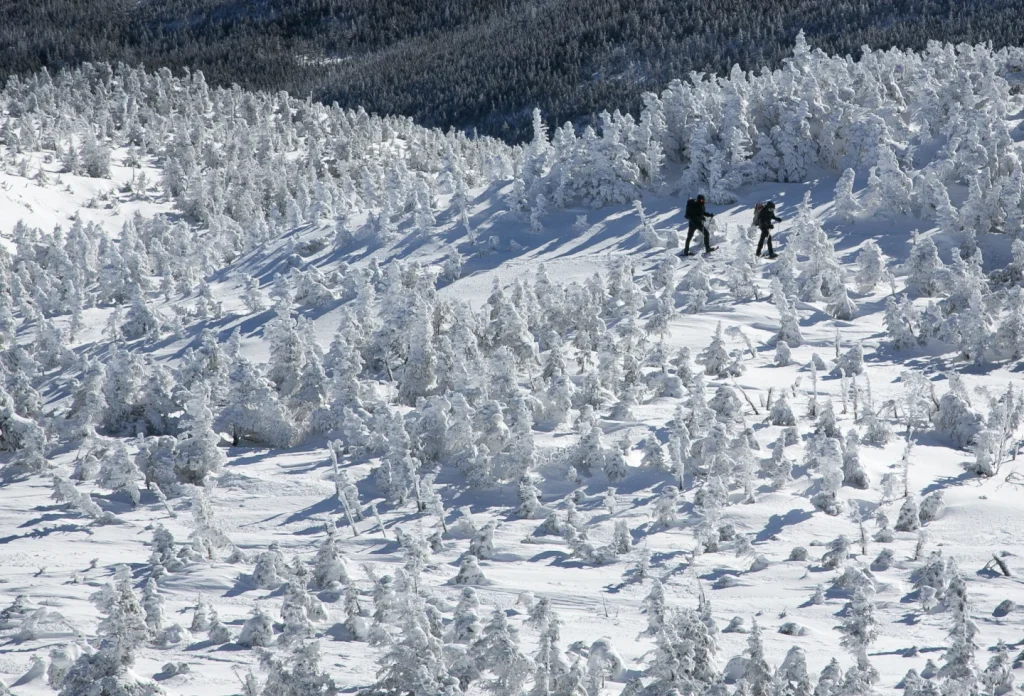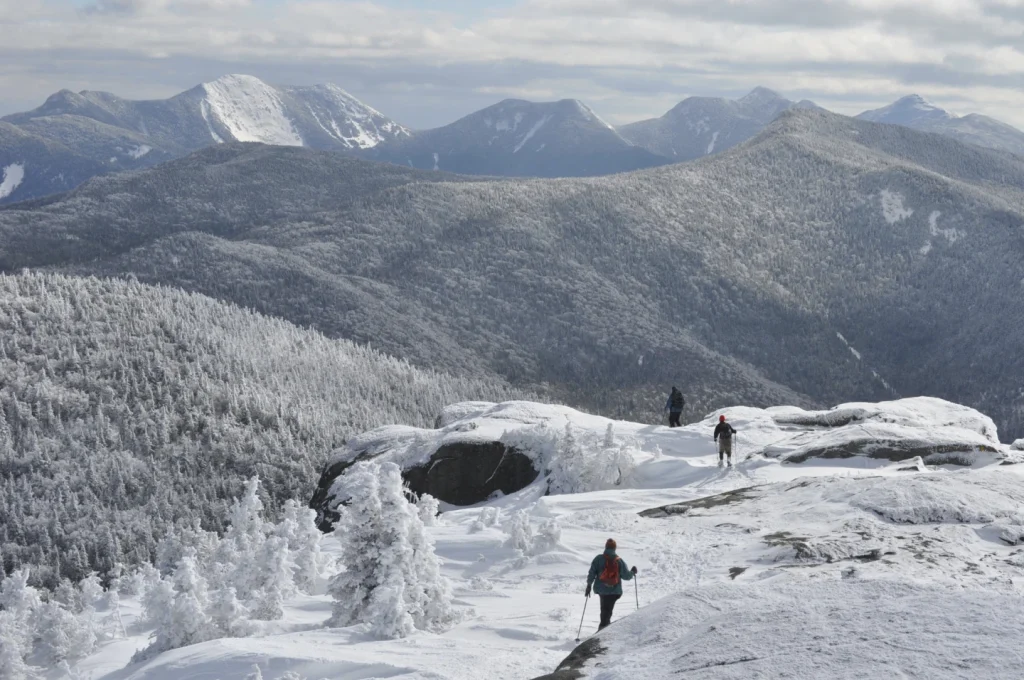Forest rangers in upstate New York recently demonstrated their exceptional skill and dedication by successfully rescuing a hiker who found herself in a perilous situation on a rugged Adirondack mountain peak.
The hiker, Hope Lloyd, survived a harrowing night in subzero temperatures after slipping and falling hundreds of feet from the summit.
Her resilience and the rangers’ swift and effective response serve as a testament to the bravery and expertise of those who work tirelessly to ensure the safety of outdoor enthusiasts.
Hope Lloyd, a seasoned 46-year-old hiker, recounted her chilling experience, expressing gratitude for her survival despite the daunting circumstances. “I thought I might have froze to death.
There were like 45-mile-an-hour winds (70 kph) up there,” she shared, reflecting on the treacherous conditions she faced during her recent ordeal.
Lloyd had been embarking on a solo hike on the day after Christmas when she lost her footing at approximately 5:30 p.m. near the summit of South Dix Mountain.
The ensuing chain of events saw her sliding several hundred feet over steep snow and down a slippery rock slab, hurtling perilously toward a cliff until she was halted by a small spruce tree.
In a phone interview, Lloyd emphasized the pivotal role of this fortuitous obstruction, stating, “That’s the only thing that saved me. If I was a little bit to the left or a little bit to the right, I wouldn’t be here right now.”
The account of Hope Lloyd’s near-fatal descent and subsequent survival underscores the unpredictable and unforgiving nature of the wilderness, as well as the critical importance of preparedness and caution when venturing into such environments.
It also highlights the indispensable role played by forest rangers, whose expertise and unwavering commitment to public safety are exemplified in their swift and successful rescue efforts.
The rugged terrain of the Adirondack Mountains presents formidable challenges to even the most experienced hikers, and incidents such as Lloyd’s serve as potent reminders of the inherent risks associated with outdoor exploration.
However, the dedication and proficiency of the state rangers who responded to her distress call exemplify the invaluable role played by these professionals in safeguarding the well-being of outdoor enthusiasts.
Their unwavering vigilance and readiness to confront adversity head-on are instrumental in ensuring that individuals like Hope Lloyd, who find themselves in dire circumstances, have a chance at survival.
In conclusion, the recent rescue of hiker Hope Lloyd serves as a poignant illustration of the unpredictable and perilous nature of outdoor pursuits, as well as the indispensable role played by forest rangers in safeguarding the lives of those who venture into the wilderness.
Hope Lloyd’s survival, against all odds, stands as a testament to both her own resilience and the exceptional skill and dedication of the rangers who came to her aid.
Their unwavering commitment to public safety and their ability to navigate treacherous terrain with precision and expertise are a source of inspiration and reassurance for all who seek to explore and appreciate the natural world.
The harrowing conditions on the 4,060-foot (1,235 meter) mountain, a prominent member of the Adirondack High Peaks, presented a formidable challenge to hikers.
As recounted by Ranger Jamison Martin, the treacherous landscape was characterized by heavy rain, pockets of deep snow, and treacherous ice, all compounded by temperatures hovering in the lower 30s (around zero degrees Celsius).
In such adverse circumstances, the risk of hypothermia loomed large, with the wet and cold environment posing a grave threat to anyone caught in its clutches.
The protagonist of this gripping tale, an experienced hiker named Lloyd, had previously conquered all 46 Adirondack High Peaks not once, but twice.
However, on this fateful expedition, she found herself in a dire predicament. Exhausted and acutely aware of the perils lurking in the unforgiving terrain, Lloyd made the difficult decision to remain stationary, fearing that any attempt to move might result in a perilous slip, potentially propelling her towards the edge of a cliff.
The enveloping darkness, exacerbated by thick fog, further compounded her predicament, rendering visibility virtually non-existent.
In a moment of desperation, she reached out for assistance, recognizing the gravity of her situation and the imperative need for external aid.
Despite the adversity she faced, Lloyd’s resourcefulness shone through. Armed with an emergency blanket, she valiantly endeavored to stave off the encroaching cold by engaging in continuous, albeit limited, movement.
Her resilience in the face of adversity serves as a testament to the indomitable human spirit, demonstrating a steadfast determination to persevere against all odds.
This narrative not only underscores the inherent dangers of venturing into the wilderness, but also highlights the importance of preparedness and quick thinking in the face of unforeseen challenges.
Lloyd’s ordeal serves as a poignant reminder of the unpredictable and often unforgiving nature of the natural world, where even the most seasoned adventurers can find themselves at the mercy of the elements.
In conclusion, the account of Lloyd’s harrowing experience amidst the unforgiving terrain of the Adirondack High Peaks serves as a sobering reminder of the inherent risks associated with outdoor exploration.
Her resilience and fortitude in the face of adversity stand as a testament to the unwavering human spirit, inspiring awe and admiration in equal measure.
This tale serves as a poignant reminder of the need for vigilance, preparedness, and a deep respect for the forces of nature when venturing into the great outdoors.
The harrowing experience of the hiker who fell in the forest and was rescued by Martin and another forest ranger serves as a poignant reminder of the inherent dangers and unpredictability of outdoor activities.
The timely and heroic intervention of the rescuers, coupled with the hiker’s resilience and gratitude, encapsulates a narrative of human compassion and the triumph of the human spirit in the face of adversity.
The incident, which unfolded in the wilderness, underscores the crucial role played by individuals like Martin and the unnamed forest ranger, who selflessly dedicate themselves to safeguarding the well-being of others.
Their prompt response and unwavering commitment to aiding the distressed hiker exemplify the noble qualities of compassion, bravery, and selflessness that are emblematic of those in the field of emergency services and rescue operations.

The hiker’s ordeal, enduring a fall in the wilderness and subsequently being attended to by the rescuers, is a testament to the resilience of the human body and spirit.
Despite suffering scrapes and bruises, the hiker’s unwavering gratitude and acknowledgment of the potential severity of the situation reflect a profound sense of appreciation for the assistance rendered.
Her expressed desire to embrace everyone who contributed to her rescue is a poignant manifestation of the human capacity for empathy and gratitude in the face of adversity.
Furthermore, the sequence of events, from the initial fall to the eventual reunion with her vehicle, serves as a narrative of survival, resilience, and the unwavering human spirit.
The provision of warm liquids, food, and dry clothing by the rescuers not only highlights their preparedness and resourcefulness but also underscores the importance of swift and effective aid in mitigating the impact of such unforeseen circumstances.
The hiker’s hometown of South Glens Falls, New York, now stands as a backdrop to this remarkable tale of survival and human compassion.
The incident has not only brought attention to the valiant efforts of the rescuers but also serves as a reminder of the potential dangers inherent in outdoor activities, and the imperative need for adequate preparation and caution when venturing into natural environments.
In conclusion, the account of the hiker’s fall and subsequent rescue by Martin and the forest ranger is a testament to the indomitable human spirit, the selfless dedication of those in the field of emergency services, and the significance of gratitude and resilience in the face of adversity.
It serves as a poignant reminder of the unpredictable nature of outdoor pursuits and the vital role played by individuals who place themselves in harm’s way to aid others.
This narrative stands as a testament to the triumph of the human spirit and the enduring power of compassion and gratitude in the face of adversity.
I have endeavored to present a comprehensive and formal essay on the given topic, encapsulating the significance of the event and its broader implications.
